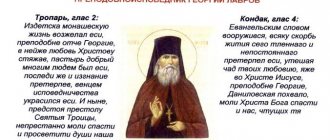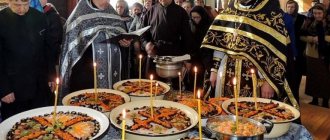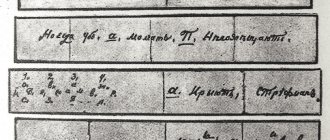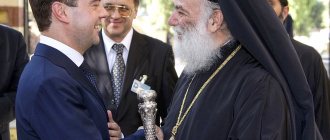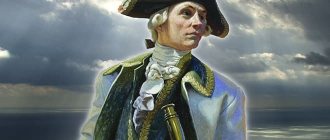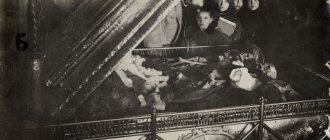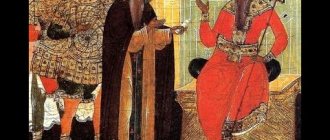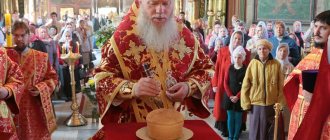Life of the Reverend
Theodore’s life is an example of earnest service to God’s cause; he always chose the hardest, so-called menial work, and strove to fulfill all the behests and instructions of his confessor, Elder Plato.
Christian education
Theodore was born in Constantinople in 758. His father, the king's tax collector, Fotin, and his mother, Theoktista, were considered pious Christians in the city, which is probably why their son studied with the best theologians and orators of Constantinople from childhood.
Venerable Theodore the Studite
Thanks to his noble origin, Theodore, who was born into a family of believing parents, had the opportunity from childhood to study with the best theologians of Constantinople, thus becoming familiar with Orthodoxy from an early age. In addition, the boy was so fascinated by Christianity that he preferred reading the Holy Scriptures to ordinary youthful pastimes.
Having entered the service of the emperor upon reaching adulthood, Theodore was soon forced to leave it due to his total rejection of the views of Constantine Copronymus and his iconoclastic activities. A little later, Theodore’s parents decided to give away all their property and, having agreed to separate, devoted themselves to serving the Lord by becoming a monk.
The path to monasticism
Theodore became famous in the capital of Byzantium for often participating in organized discussions about the veneration of icons, from which he often emerged victorious, thanks, of course, to his knowledge of the text of the Holy Scriptures, religious dogma and his perfect mastery of the art of orator.
The Ecumenical Council that took place in the 7th century put an end to iconoclasm. One of the fathers of the Council, Plato, who was also Theodore’s uncle, gathered at the end of the Council his nephews, whose names were Joseph, Euthymius and Theodore, and called them to monasticism and life in the desert. Accepting this instruction as the best for their spiritual life, they all soon left Constantinople together and stopped at a small place called Sakoudian.
Here it was decided to erect a temple dedicated to St. John the Theologian, around which a monastery gradually arose, of which Elder Plato became the abbot. After several years, Theodore, following the instructions of his confessor, became a presbyter, and then, after the death of Plato, he was elected by the brethren as abbot of the monastery.
Important! Saint Theodore, in his ministry, was always distinguished by his fierce devotion to the cause of Christ and selflessly followed the church canons, but it should be noted that at the same time he fearlessly fought with the Emperor Constantine himself, for he violated the church canons many times.
Theodore notified all nearby monasteries that the emperor must certainly be excommunicated from the Church, since he had repeatedly destroyed church ideas about marriage.
Link period
The consequence of this decision of Theodore was his exile along with ten companions to the city of Thessaloniki, but no matter how the emperor fought with Theodore, he did not cease to expose his morals from any place and being in absolutely any conditions. When Empress Irina was able to return to the throne, she immediately freed Theodore, this happened in 796.
Icon of St. Theodore the Studite
In addition, she handed over to him a monastery that had been empty for a long time - the Studite monastery, where in a fairly short amount of time more than a thousand monks arrived, ready to serve in this abandoned place. The Monk Theodore wrote a charter, which became known as the Studian Charter, regulating the basic rules of monastic life.
After the accession of Emperor Nicephorus to the throne, a new series of church violations began - the once excommunicated presbyter was reintroduced to church activities. The Monk Theodore continued to make speeches denouncing the actions of the emperor, for which he was subjected to torture and beatings, and then again sent into exile. After 2 years, Theodore was released by the new emperors who seized the throne - Michael, who replaced Nicephorus, who was killed in hostilities.
Interesting! The death of Emperor Nicephorus and his son Stavrikiy was once predicted by Theodore.
Returning to the reign of Emperor Michael, one cannot ignore the fact that, trying to avoid internecine wars, he ceded the imperial post to Leo the Armenian, his military commander. Unlike the previous emperor, Leo turned out to be a cruel iconoclast; no matter how many priests tried to reason with the emperor, all attempts were unsuccessful. The result of Emperor Leo's reforms were:
- imposing a ban on the veneration of icons;
- desecration of holy iconographic images.
The Monk Theodore did not think of giving up, so he and his assistants organized a procession of the cross around his monastery with icons held high and singing. The emperor answered Theodore with a threat of the death penalty to such an open protest, but this did not stop the monk. The emperor again sent Theodore into exile, first to Illyria and then to Anatolia, but the priest, devoted to the cause of God, continued to fight godlessness there too. For refusing to renounce their views, Theodore and his assistant Nicholas, who was in exile with him, were deprived of water and food, and were also constantly subjected to beatings.
Interesting! Despite his difficult physical condition, Theodore, while in Smyrna, saved the governor, who was also the king’s nephew, from a serious illness, asking him to repent of his sins and accept the Lord as his savior, but the governor soon again surrendered to heresy and soon died.
Liberation and the end of the earthly path
The murdered Emperor Leo was replaced by a new one - Michael Travlius, who freed all the companions of Christ from exile, however, left one ban on the veneration of icons in Constantinople. After his release, Theodore decided to go to Bithynia, to the city of Chersonesos, where he settled near the church of the Great Martyr Tryphon.
Icon of Theodore the Studite
Being seriously ill, Theodore continued to perform the liturgy every day and conduct soul-saving mentoring conversations with the monks. Feeling his imminent death, in 826, the monk called the brethren and asked them to begin singing the sacred canon for the exodus of the soul; when the monks finished singing the last lines, they saw that Theodore had already gone to God.
Monastic career
The VII Ecumenical Council rejected the likening of holy icons to vile idols, approved the veneration of icons, and condemned heretics. Among the participants in the Council was Theodore's uncle, the righteous Plato. For a long time he lived and labored on Olympus. At the end of the Council, Plato took Theodore under his mentorship. Together with him he took his brothers, Joseph and Euthymius, as well as his young sister. All together they retired to the desert to indulge in ascetic deeds there.
As a place of asceticism, they chose a hard-to-reach, but very picturesque and well-watered place: Sakkudion. Staying in love and like-mindedness here, they labored in fasting, vigil and prayer.
Having passed the tests with dignity, Theodore was tonsured as a monk by Blessed Plato. Of all the monastic virtues, he considered obedience and humility to be the most important. Following this inner conviction, he not only did not hesitate to carry out assignments associated with the dirtiest and hardest work, but often chose this work for himself: he cut down and uprooted trees, dug up the earth, carried stones, carried water from the river, collected and carried there is dung on the shoulders (from mules). Often, in order to avoid vain praise, he worked at night.
Theodore sincerely confessed his sins to Elder Plato, revealing not only his actions, but also his deepest thoughts. He listened to the wise admonitions and commands of his confessor as if the Lord Himself was speaking through him. Under the leadership of Plato, Theodore, step by step, revealed God's gifts in himself, mortified passions, and cultivated virtues.
When the time came, Elder Plato entrusted Theodore with the construction of a temple in honor and memory of the Evangelist John the Theologian. Despite the paucity of possibilities for construction and decoration, the temple turned out to be excellent. For example, it was composed of many different stones and decorated with multi-colored paints.
Soon people began to flock to the brethren, seeking wise guidance and blessings, wanting to connect their lives with ascetic work. This is how a monastery was formed, the rector of which, according to God’s Providence, was the spirit-bearing Plato.
Along with fulfilling monastic obediences, the brethren were engaged in studying the Holy Books, reading the works of the fathers and ecumenical teachers. Theodore himself devoted a lot of time to the thought of God, and from patristic literature he paid special attention to the writings of St. Basil the Great.
Reverence
During his lifetime, the Monk Theodore performed many miracles; it is known from church traditions that the name of this saint was announced during a fire and saved people from attacks by wild animals. Many cases of healing are described in the life of the saint.
It is customary to pray to Theodore the Studite to protect one’s home from fire, for diseases of the stomach and respiratory system, and in situations involving risk.
Attention! In Russia, in Moscow, there is the Feodorovsky Church, famous for the fact that the poet Alexander Sergeevich Pushkin and Natalya Goncharova were married there.
Several dates are associated with the veneration of Theodore the Studite in the church:
- day of death - November 24 (11 old style);
- the day of the transfer of holy relics from Studite to Chersonesus is February 8 (January 26).
Traditions and rituals for the holiday of Fyodor the Studite
The main tradition on November 24 is eating hot cabbage soup.
- The nickname of Fyodor (Theodore) - Studit - was interpreted by the Russian people in their own way, calling the saint also Moroz. “Fyodor is chilling the earth,” people said. And, seeing the inevitable onset of winter, they added: “The cold from Studite is worse every day.” The dampness on this day foreshadowed prolonged thaws until the Introduction.
— Wise people advised to spend Fedorov’s Day at home, closer to the stove and hot cabbage soup. On this occasion they said: “You won’t catch a cold on the stove and near hot cabbage soup even on Studite Day.” The cabbage soup had to be consumed immediately after removal from the heat. It was believed that the winter temperature directly depends on this: the more hot cabbage soup, the warmer the winter will be.
— November 24 was considered one of the outstanding days in determining winter weather - whatever the day, such will be the winter. If Fyodor Studite's day was warm, then the winter will be warm, but if it is cold, then the whole winter will be cold. Fedor was also used to judge the future harvest of berries and mushrooms. If there were a lot of stars in the sky, it was possible to stock up on baskets and items for the summer. For the omen to come true, on this day they had to brew tea with dried berries - raspberries, strawberries, blueberries.
Books and works, messages
Theodore the Studite, who devoted his entire life to worship, left behind quite a lot of works, the main part of which can be divided into such topics as:
- refutation of iconoclasm;
- catechumens;
- about Easter;
- explanation of the Divine Liturgy;
- Sunday readings.
Book of Abbot Theodore Studite
Absolutely all of the works of St. Theodore can be purchased through Orthodox book websites, as well as read online.
Heritage
Theodore's revival of the monastery of Stoudios had a great influence on the later history of Byzantine monasticism. His disciple, Naucrates, regained control of the monastery after the end of the Iconoclasm in 842, and throughout the remainder of the ninth century, Studite abbots continued Theodore's tradition of resisting patriarchal and imperial authority.[64] Elements of Theodore's Testament
were literally included in the typography of some early Athos monasteries.[65] The most important elements of his reform were the emphasis on communal life, manual labor, and a clearly defined administrative hierarchy.[66]
Theodore also developed the monastery of Stoudios into a major scientific center, in particular thanks to its library and scriptorium, which certainly surpassed all other modern Byzantine ecclesiastical institutions in this regard.[67] Theodore himself played a key role in the revival of classical literary forms, particularly iambic verse, in Byzantium, and his criticism of iconoclastic epigrams established a connection between literary excellence and orthodox faith.[68] After his death, the monastery of Stoudios continued to be an important center for Byzantine hymnography and hagiography, as well as the copying of manuscripts.[67]
After the “triumph of Orthodoxy” (that is, the restoration of icons) in 843, Theodore became one of the great heroes of the iconoclastic opposition. There was no formal canonization process in Byzantium, but Theodore was soon recognized as a saint. In the Latin West, a tradition arose in which Theodore recognized papal primacy, based on his letters to Pope Easter I, and he was officially canonized by the Catholic Church. Its festival is November 11 in the East and November 12 in the West.[69]
Works
Theodore was an extremely prolific writer; Among his most important works:
- His letters, which convey many personal details, also highlight a number of his historical events. Ed. with summary in German by Georgios Fatouros, Theodori Studitae Epistulae
(=CFHB 31) (Berlin, 1992) [two volumes]. ISBN 3-11-008808-8. - His poems, which represent an important stage in the revival of classical verse in Byzantium. Ed. with German translation by Paul Speck, Theodoros Studites: Jamben auf verschiedene Gegenstände
(= Byzantine Supplement 1) (Berlin, 1968). - Catechisms, two collections of addresses to monks on various topics related to spiritual life. First collection (“magna”) ed. A. Papadopoulos-Kerameous, Theodori Studitae Magna Catachesis
(St. Petersburg, 1904);
second (“parva”) ed. E. Auvray, S.P.N.
et Confessoris Theodori Studitis Praepositi Parva Catachesis (Paris, 1891), French translation by Anne-Marie More,
Petites catéchèses
(=
Les Pères dans la foi
52) (Paris, 1993). - His mother's funeral. Ed. etc. St. Efthymiadis and J. M. Featherstone, "Establishing the Sacred Line of Succession: The Funeral Catechism of Theodore the Stoudite for His Mother (Bibliotheca hagiographica graeca 2422)", in M. Grünbart, ed., Theatron: rhetorische Kultur in Spätantike und Mittelalter
(= Millennium -Studien 13) (Berlin, 2007), pp. 13–51. ISBN 3-11-019476-7. - Funeral of Uncle Plato ( Theodori Studitae Oratio funebris in Platonem ejus patrem spiritualem
, 99, pp. 803–850). - Various polemical discourses related to the question of image worship, in particular Theodori praepositi Studitarum Antirrhetici adversus Iconomachos
,
PG
99, 327B-436A and
Theodori Studitae Refutatio et subversio impiorum poematum Ioannis, Ignatii, Sergii, et Stephani, Recentium christomachorum
Cf.
selection, translated by Catherine Roth, On Holy Icons
(Crestwood, 1981). ISBN 0-913836-76-1 - His Testament
, dictated to his disciple Naukratios at the end of his life:
PG
99, 1813-24.
English translation by Timothy Miller, in J. Thomas and A. C. Hero, eds., Documents of a Byzantine Monastery
(=
Dumbarton Oaks Studies
35) (Washington, 2000), I.67–83. ISBN 0-88402-232-3; Available online. - Sermon on the Apostle Bartholomew, ed. with the Italian translation by Giorgio di Maria in V. Giustolisi, ed., Tre laudationes bizantine in onore di San Bartolomeo apostolo
(Palermo, 2004).
References
Quotes
- Brown 1933, para. 76; Chisholm 1911, “Theodore - Theodosia”, p. harvnb error 769: multiple targets (2×): CITEREFChisholm1911 (Help).
- Chisholm 1911, “Theodore - Theodosia”, p. harvnb error 769: multiple targets (2×): CITEREFChisholm1911 (Help).
- He is described as tamias tōn basilikn phorn
, "steward of imperial money", a position which seems to have been equivalent to
basilik sacellario
. Consequently, he was an extremely high-ranking official who was on close terms with the emperor himself. (Pratsch 1998, pp. 18–21). - Theodore emphasizes the high position of her parents, Sergius and Euphemia, who died during the plague of 747/48. (Pratsch 1998, pp. 26–27).
- He was a zygostate
, a position for which he was trained by his own uncle. (Pratsch 1998, pp. 27–28). - Pratsch 1998, pp. 62–63 (including footnote no. 175).
- Pratsch 1998C. 28–29.
- Pratsch 1998C. 42–45.
- Pratsch 1998C. 67–69.
- Pratsch 1998C. 71–76.
- Pratsch 1998C. 80–81.
- She was the daughter of Anna, sister of Theoktistus. (Pratsch 1998, pp. 53, 83).
- Pratsch 1998C. 89–90.
- Pratsch 1998C. 98–101.
- Pratsch 1998C. 101–102.
- Pratsch 1998C. 107–110.
- Pratsch 1998C. 110–113.
- Pratsch 1998, para. 118.
- Pratsch 1998C. 120–122.
- Pratsch 1998, para. 125; for poetry, Speck 1984, Jamben
pp. 114–174 (Epigrams 3–29). - Pratsch 1998, para. 126.
- Pratsch 1998C. 128–133.
- Pratsch 1998C. 122–123 (with notes).
- Pratsch 1998C. 135–136.
- Pratsch 1998C. 139–140.
- Pratsch 1998, para. 142.
- Pratsch 1998C. 144–145.
- Pratsch 1998C. 147–149.
- Pratsch 1998C. 151–153.
- Pratsch 1998C. 153–157.
- Pratsch 1998C. 159–161.
- Pratsch 1998C. 162–163.
- Pratsch 1998, para. 167.
- Pratsch 1998C. 170–171.
- Pratsch 1998, para. 173.
- Pratsch 1998C. 175–176.
- Pratsch 1998, para. 183.
- Pratsch 1998C. 189–191.
- Pratsch 1998C. 192–196.
- Pratsch 1998C. 196–199.
- Pratsch 1998, para. 201.
- Pratsch 1998, pp. 203–204 (with note 8).
- Pratsch 1998C. 204–223.
- Pratsch 1998C. 229–230.
- Pratsch 1998, pp. 231–234 and 247.
- Pratsch 1998, para. 234.
- Pratsch 1998C. 242–243.
- Pratsch 1998C. 245–246.
- Pratsch 1998C. 235–245.
- Pratsch 1998, pp. 245–246 and 252.
- Pratsch 1998C. 246–247.
- Pratsch 1998C. 247–251.
- Pratsch 1998C. 253–254.
- Pratsch 1998C. 255–258.
- Pratsch 1998, pp. 259–261 and 263.
- Pratsch 1998C. 263–267.
- Pratsch 1998C. 268–271.
- Pratsch 1998, para. 278.
- Pratsch 1998C. 281–288.
- Pratsch 1998C. 278–281.
- Pratsch 1998, para. 288.
- Thomas, Hero and Constable 2000, I.68.
- Pratsch 1998C. 288–291.
- Thomas, hero and constable 2000C. 68–69.
- Thomas, Hero and Constable 2000, I.72 and I.84.
- Thomas, Hero and Constable 2000, I.85-87.
- ^ a b
Pratsch 1998, paragraph 306. - Speck 1984, pp. 194 (with note 18), 203.
- Pratsch 1998C. 311–313.
- Bracket 1888, item 42.
Research
- Brace, Charles Loring (1888). Gesta Christi, or the History of Humane Progress under Christianity
(4th ed.). New York, New York: A.C. Armstrong & Son.CS1 maint: ref=harv (site link) - Brown, Lawrence Edward (1933). The Eclipse of Christianity in Asia: From the Time of Muhammad to the Fourteenth Century
. Cambridge, UK: Cambridge University Press.CS1 maint: ref=harv (site link) - Chisholm, Hugh (1911). Encyclopædia Britannica: Dictionary of Arts, Sciences, Literature and General Information, Volume 26
. Encyclopædia Britannica Co.CS1 maint: ref=harv (site link) - Hutley, Peter (1996). "The Politics of Salvation: Theodore Studios on Martyrdom ( Martyrion
) and the Speech (
Parrhesia
)."
Dumbarton Oaks Papers
.
Washington, DC: Dumbarton Oaks. 50
: 263–287. JSTOR 1291747.CS1 maint: ref = harv (link to site) - Page, Kirby (1929). Jesus or Christianity: A Study in Contrasts
. Garden City, New York: Doubleday, Doran & Company, Incorporated.CS1 maint: ref=harv (site link) - Prach, Thomas (1998). Theodoros Studites (759-826) - zwischen Dogma und Pragma: der Abt des Studiosklosters in Konstantinopel im Spannungsfeld von Patriarch, Kaiser und eigenem Anspruch
. Bern, Switzerland: Peter Lang.CS1 maint: ref=harv (link to website) - Speck, Paul (1984). “Ikonoklasmus und die Anfänge der makedonischen Renaissance.” Varia 1 (Poikila Byzantina)
.
Bonn, Germany: Dr. Rudolf Habelt GMBH. 4
: 175–210. ISBN 3-7749-2150-4 .CS1 maint: ref = harv (link to website) - Thomas, J.; Hero, Angela Constantinides; Constable, Giles (2000). Documents of the Byzantine Monastic Foundation: A Complete Translation of the Typica and Testaments of the Surviving Founders, Volume 1
. Washington, DC: Dumbarton Oaks Studies (Vol. 35). ISBN 0-88402-232-3 .CS1 maint: ref = harv (website link) (Text online)
